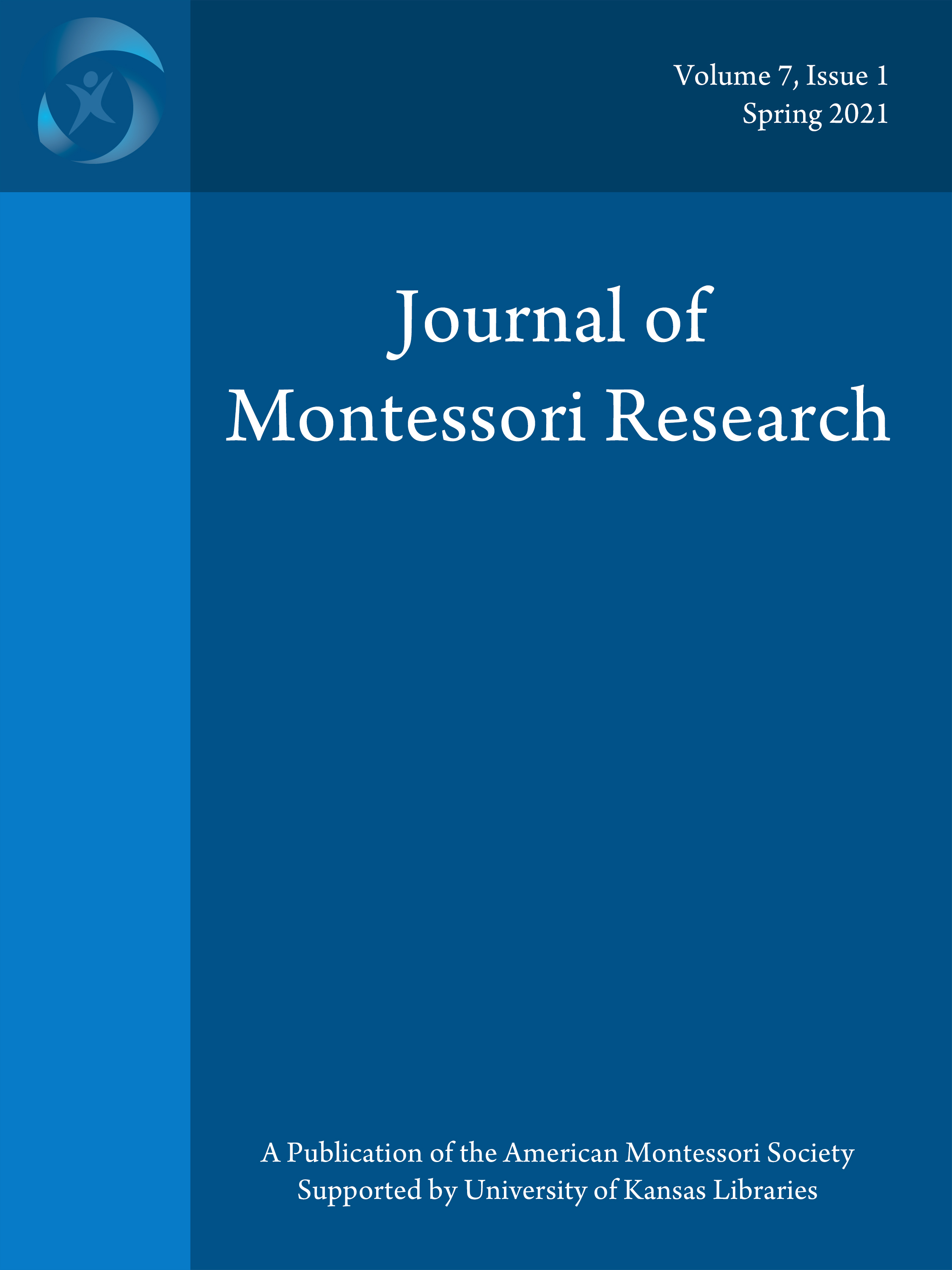Second Language Corner for Children’s House
A Practitioner–Researcher Journey Into Bilingualism in Montessori Education
DOI:
https://doi.org/10.17161/jomr.v7i1.13401Keywords:
TESOL, bilingualism, L2, Montessori, qualitative research, young learnersAbstract
This work reports, from a qualitative research perspective, the development of an English Corner project for a preschool Children’s House classroom in central Mexico over the course of a 3-year period. It shows the transition of a language specialist over six consecutive periods of work, from a traditional understanding and practice of teaching English as a second language to young learners into a more comprehensive one of the Montessori Method. The analysis of my own practice is used to recover insights through a reflective process with the intention to develop a second language (L2) Montessori program for 3- to 6-year-olds that aligns better with Montessori pedagogy. Variables such as instruction time, setting, group constitution, materials, and teaching and learning strategies allowed for certain aspects to arise as leading points of interest for the focus of the analysis and the methodological and pedagogical adaptations that followed each period. This paper is an attempt to fill the gap between the need to deliver a second language effectively in Montessori education and the lack of guidance for doing it the Montessori way; it is especially for practitioners who do not have a Montessori background but also for Montessori-trained teachers for whom more specific preparation would aid their practice. I also hope to stimulate further research in the field of second language acquisition and multilingualism in Montessori education at every level of education.
References
Bagby, J. H. (2007). Montessori education and practice: A review of the literature, 1996–2006, Montessori Life, 1, 1–8. https://amshq.org/-/media/Files/AMSHQ/Research/Resources-for-Research/A-Review-of-the-Literature-1996_2006.ashx?la=en
Bagby, J. H., & Jones, N. A. (2010). Montessori education and practice: A review of the literature, 2007–2009. Montessori Life, 2, 1–5. https://amshq.org/-/media/Files/AMSHQ/Research/Journal-Articles/Reviewof-the-Literature-2007_2009.ashx
Bagby, J., Wells, K., Edmonson, K., & Thompson, L. (2014). Montessori education and practice: A review of the literature, 2010–2013. Montessori Life, 5, 32–41.
Berger, B., & Eßwein, L. (2016). Englisch lernen nach Montessori [Learning English according to Maria Montessori]. Herder Verlag.
Berger, B. (2019a). What about young learners? How much autonomy is possible at primary level? Independence, 76, 26–28.
Berger, B. (2019b). Materials that support learner autonomy in primary classrooms. Independence, 77, 19–21.
Biggs, J. (2006). Teaching for quality learning at university. Open University Press.
Campbell, M. H. (1998). Fort Peck combines language immersion with Montessori methods. Tribal College Journal, 9(4), 15. https://tribalcollegejournal.org/fort-peck-combines-language-immersionmontessori-methods/
Consalvo, G., & Tomazzolli, E. (2019, March 21–24). Fostering multilingual competence in a Montessori elementary school context [Poster presentation]. The Montessori Event, Washington, D.C., United States. https://amshq.org/-/media/Files/AMSHQ/Research/Conference-Handouts/2019/Poster-Sessions/Consalvo.ashx
Cummins, J. (1996). Negotiating identities: Education for empowerment in a diverse society. California Association for Bilingual Education.
Dooly, M., & Moore, E. (2017). Introduction: Qualitative approaches to research in plurilingual education. In E. Moore & M. Dooly (Eds.), Qualitative approaches to research on plurilingual education (pp. 1–10). https://doi.org/10.14705/rpnet.2017.emmd2016.618
Epstein, P. (2012). An observer’s notebook: Learning from children with the observation C.O.R.E. Montessori Foundation.
Fafalios, I. (2007). Supporting bilingual children. Montessori Society AMI (UK). https://montessorisociety.org.uk/Articles/4333290
Farrell, T. S. C. (1994). Exploring EFL classrooms at a Korean university. English Teaching, 49, 285–309. http://journal.kate.or.kr/wp-content/uploads/2015/02/kate_49_14.pdf
Geertz, C. (1973). The interpretation of cultures: Selected essays. Basic Books.
Jacobs, S. (2016). The use of participatory action research within education: Benefits to stakeholders. Word Journal of Education, 6(3), 48–55. http://dx.doi.org/10.5430/wje.v6n3p48
Jendza, J. (2016). Foreign languages in the Montessori environment: A participatory action research—the first cycle. Beyond Philology: An International Journal of Linguistics, Literacy Studies and English Language Teaching, 13, 287–305. https://fil.ug.edu.pl/sites/default/files/_nodes/strona-filologiczny/33797/files/beyond_philology_no_13.pdf
Krashen, S. D. (1985). The input hypothesis: Issues and implications. Longman.
Lillard, A. (2008). How important are the Montessori materials? Montessori Life, 20(4), 20–25.
Lillard, A. (2011). What belongs in a Montessori Primary classroom? Results from a survey of AMI and AMS teacher trainers. Montessori Life, 23(3), 18–32. https://www.researchgate.net/publication/290448065_What_Belongs_in_a_Montessori_Primary_Classroom
Lillard, A. S. (2012). Preschool children’s development in classic Montessori, supplemented Montessori and conventional programs. Journal of School Psychology, 50(3), 379–401. https://doi.org/10.1016/j.jsp.2012.01.001
Lillard, A., & Heise, M. (2016). Removing supplementary materials from the Montessori classroom changed child outcomes. Journal of Montessori Research, 2(1), 16–26. https://doi.org/10.17161/jomr.v2i1.5678
Menezes, V. (2013). Second language acquisition: Reconciling theories. Open Journal of Applied Sciences, 3(7), 404–412. https://doi.org/10.4236/ojapps.2013.37050
Montessori, M. (2007a). The absorbent mind. Montessori-Pierson.
Montessori, M. (2007b). The formation of man. Montessori-Pierson.
Montessori, M. (2012). The 1946 London lectures. Montessori-Pierson.
Park, C., & Lee, H. (2010). What makes a case study really qualitative? Show me your evidence, please! English Teaching, 65(4), 79–101. https://doi.org/10.15858/engtea.65.4.201012.79
Rosales Chavarría, R. (2019, September 6). Curricula development for learning languages in Montessori settings [Paper presentation]. LASIG Event, Reforming the foreign language classroom: Empowering students to take ownership. Braunschweig, Germany.
Rosanova, M. (1997). Early childhood bilingualism in the Montessori Children’s House: Guessable context and the planned environment. InterCultura Montessori School.
Rosanova, M. J. (1998). Early childhood bilingualism in the Montessori Children’s House (ED409704). ERIC. Montessori Life, 10(2), 37–48. https://files.eric.ed.gov/fulltext/ED409704.pdf
Snow, C. (1983). Literacy and language: Relationships during the preschool years. Harvard Educational Review, 53(2), 165–189. https://doi.org/10.17763/haer.53.2.t6177w39817w2861
Winter, C. (2020). Creating an environment for learner autonomy. Melta News, 99, 1–11. https://melta.de/wp-content/uploads/2020/06/melta_99_summer20_web3.pdf
Winnefeld, J. (2012). Task-based language learning in bilingual Montessori Elementary schools: Customizing foreign language learning and promoting L2 speaking skills. Linguistik Online, 54(4), 69–83. https://doi.org/10.13092/lo.54.284
Wysmulek, I. (2009). Montessori Method in teaching foreign languages. Наукові записки Національного університету “Острозька академія.” Серія ≪Філологічна≫ [Scientific notes of the National University “Ostroh Academy.” Philological Series], 11, 446–454. https://eprints.oa.edu.ua/255/1/11_09_18.pdf
Downloads
Published
Issue
Section
License
Copyright (c) 2021 Romali Rosales Chavarria

This work is licensed under a Creative Commons Attribution-NonCommercial 4.0 International License.


